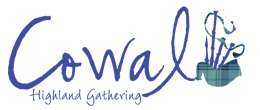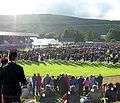Cowal Highland Gathering
| Cowal Highland Gathering | |
|---|---|
 | |
| Genre | Highland Gathering |
| Dates | Final weekend in August annually |
| Location(s) | Dunoon, Cowal, Argyll and Bute |
| Coordinates | 55°57′32″N 4°55′26″W / 55.959°N 4.924°W |
| Country | Scotland, United Kingdom |
| Years active | 1894–present |
| Website | |
| CowalGathering.co.uk | |
The Cowal Highland Gathering (also known as the Cowal Games) is an annual Highland games event held in the Scottish town of Dunoon, on the Cowal peninsula in Argyll and Bute, over the final weekend in August.
History
The first Cowal Games was held in Dunoon in 1894, and attracted fewer than 2,000 spectators. By 1901, attendances reached 5,000, and the first overseas competitor, an American athlete, took part.[1]
1906 saw the introduction of a pipe band competition. In 1929, the first approaches from Scottish societies overseas were received, and this has continued as expatriates the world over have turned to Dunoon for advice and practical assistance in setting up their own Gatherings.[2]

After a break during the years of World War II, the first post-war Gathering, in 1946, attracted attendances of 28,000. However, the record attendance, to date at least, was in 1950 when 30,000 visitors attended,.[3] one of whom was then-Prime Minister Clement Attlee.[3]
In 2000, changes to the Highland dancing format resulted in the Friday becoming a high-profile day, with the top dancers out to qualify for Saturday's finals. The Solo Bagpipe competition introduced a graded system. Shinty was reintroduced, attracting high-calibre competitions.
2003 saw Cowal extended to a three-day event with the introduction of the Scottish National Highland Dancing Championships and the five-kilometre Cowal Run.
The 2007 event saw controversy when it was announced that the committee had decided to abandon the track, athletic and shinty competitions. Other changes made in 2007 were the introduction of a Most Entertaining Band competition and the mace-over-the-bar competition.
In 2009 a children's entertainment tent was added to the attractions as was an upgraded food court featuring "Food from Argyll" a collection of local producers who bring local produce to the event.[4]
Present times
Nowadays, the Cowal Games attracts more than 3,500 competitors, with many coming from overseas countries, including Canada, USA, Australia, New Zealand and South Africa. Dunoon regularly welcomes around 15,000 to 20,000 visitors for the Games, doubling the town's population for the weekend.[5]
Pipe bands
On the Saturday morning, on average, 150 pipe bands arrive to contest the Cowal Championships. The day starts with bands marching from Dunoon pier, up Argyll Street, Dunoon's main thoroughfare, to the stadium, a distance of approximately one mile. On completion of the day's events, the bands close the Gathering with the march-past [6] and salute to the chieftain of the Games by 3,000 pipes and drums. The bands then march back to the pier, displaying the trophies they have won on the day.
As a result of the changes that the Gathering introduced for the 2007 event, and the positive feedback from competitors and spectators alike, discussions involving the RSPBA resulted in a new three-year deal being agreed commencing with the 2008 Gathering.
Loss of 'major' status
In January 2013, following a meeting between the Gathering Committee and the RSPBA, it was announced that, from 2014, Cowal would lose its status as a 'major' Pipe Band competition, a status enjoyed by the event since 1906.[7] The Gathering chairman admitted that the major competition had outgrown the limited facilities at Dunoon Stadium. As a result, only 24 pipe bands registered to compete at the 2014 gathering, although most competed in several events when they would have only competed once previously.
Highland dancing
The Cowal Gathering is host to some of the most prestigious Highland dancing competitions in the world, including the World Championships. Around 750 dancers compete over the three days with many travelling from Canada, the USA, Australia and New Zealand.
The finals of the Championships takes place on the Saturday of the event.
Gallery
 The massed bands play in salute to the chieftain of the Games
The massed bands play in salute to the chieftain of the Games Highland dancing at the 2008 event.
Highland dancing at the 2008 event. The weight-over-the-bar competition, one of the Heavy Athletic events.
The weight-over-the-bar competition, one of the Heavy Athletic events. The mace-over-the-bar competition.
The mace-over-the-bar competition.
References
- ↑ cowalgathering.com. "History of the games 1894". Archived from the original on 2009-04-28. Retrieved 2011-08-28.
- ↑ cowalgathering.com. "History of the games 1929". Archived from the original on 2009-04-28.
- 1 2 cowalgathering.com. "History of the games 1946". Archived from the original on 2009-04-28.
- ↑ heraldscotland.com. "Cowal Gathering turns its back on track". Archived from the original on 2007-09-29.
- ↑ cowalgathering.com. "History of the games 2003". Archived from the original on 2009-04-28.
- ↑ "Home | Scotland on TV from STV". Scotlandontv.tv. Retrieved 2013-08-30.
- ↑ "Gathering Storm". Dunoon-observer.com. 2013-01-22. Retrieved 2013-08-30.
External links
- Map sources for Cowal Highland Gathering
| Wikimedia Commons has media related to Cowal Highland Gathering. |
